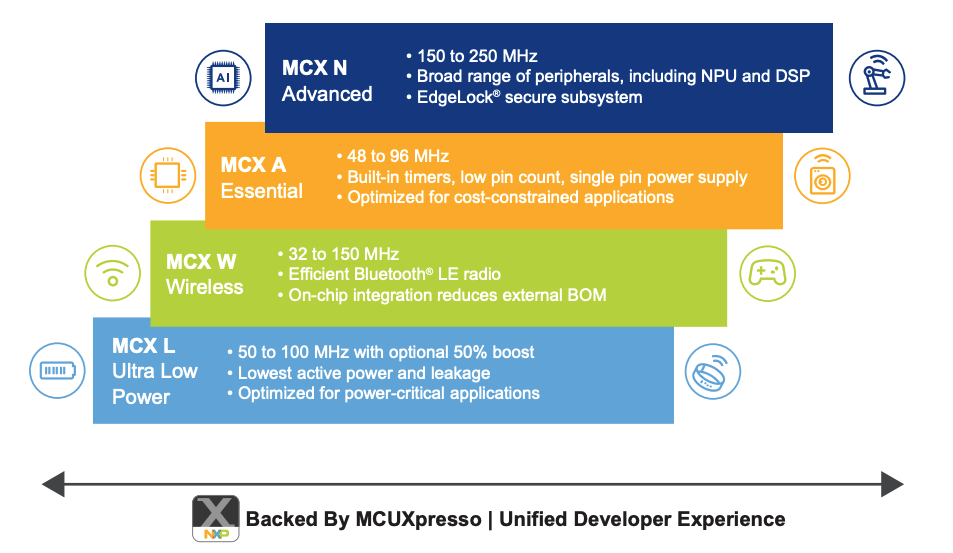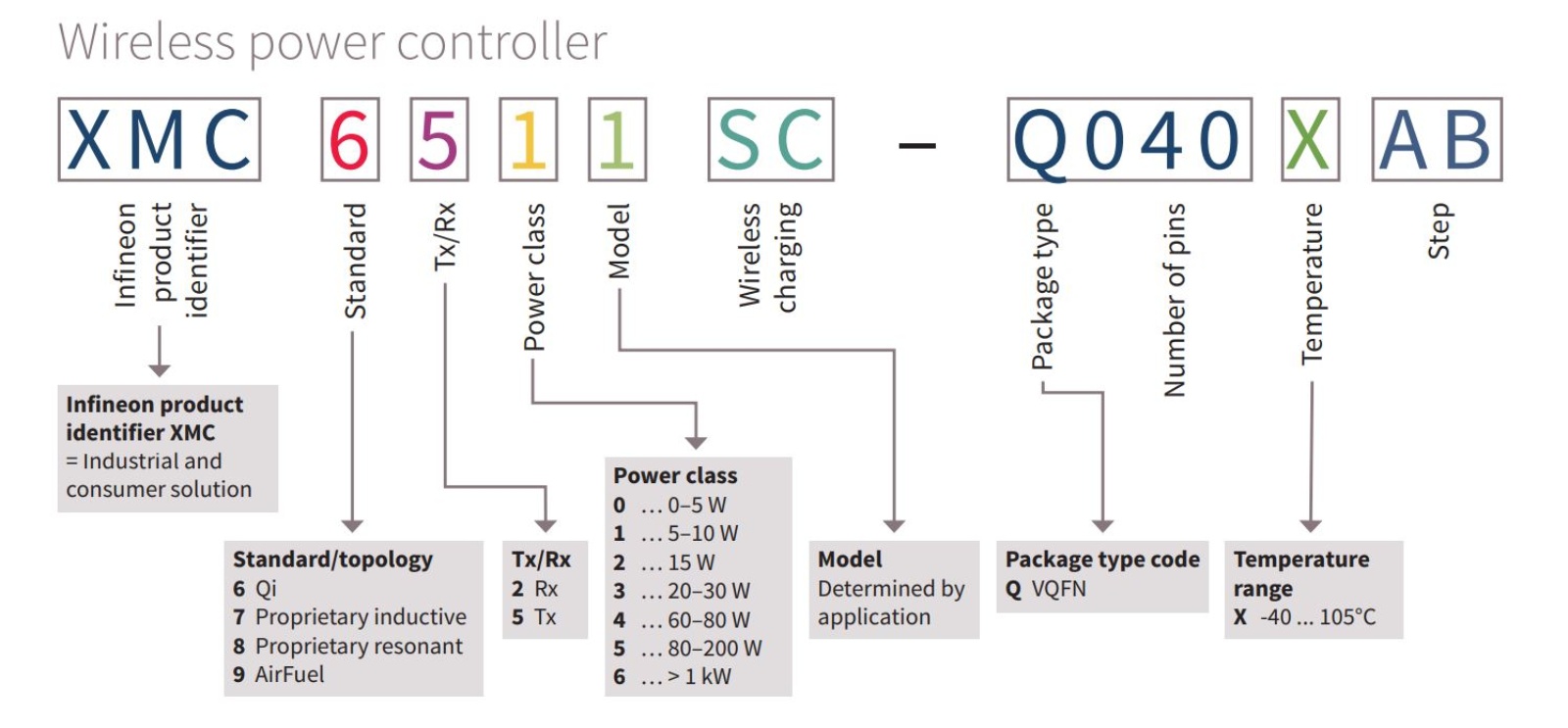NXP it is, this month
30
Jun
2022
It was a slow month with a silver lining: NXP announced a full new portfolio of Cortex-M33 based devices spanning 4 series from ultra low power to top of the line MCUs with the capability to perform AI at the edge. Alas, there were no mentions of price, products and availability. All in due time, it seems…
Dialog got acquired by Renesas last year, and surprise, this month, the site is now redirected to Renesas.
So long Dialog-Semiconductor, we will see you now on https://www.renesas.com.
Infineon released a few variants of existing products in the PSoC6 family, mostlty to add QFN packages.
As a reminder, Infineon has now completed the integration of the Cypress parts and website.
Here is the summary:
PSoC™ 4 Low power and integration for Industrial and Consumer applications (Cortex-M0/M0+)
This is the workhorse and features a wide array of peripherals including analog sensor integration, capactitive touch, and wireless connectivity, some of which can be software configured through a drag and drop user interface: Capacitive Sensing, Programmable Analog Blocks, Programmable Digital Blocks and Wired and Wireless Connectivity.
PSoC™ 4 Purpose-built for the IoT (Cortex-M4+ + Cortex-M0+)
The PSoC™ 6 family focuses on low power and the highest level of security (as defined by the ARM Platform Security Architecture) with the flexibility to run complex algorithms on the Cortex-M4 while keeping the power consumption low with the COrtex-M0+.
XMC™ 1000/4000One MCU Platform, Countless solutions
The family is dedicated to applications in the segments of power conversion, factory and building automation, transportation, and home appliances. XMC1000 bring together the Arm® Cortex®-M0 core and market-proven and differentiating peripherals in a leading-edge 65 nm manufacturing process. XMC4000 are powered by Arm® Cortex®-M4 with a built-in DSP instruction set.
In the process, the following families have been put on the chopping block (under the legacy category):
- FM0+ Cortex M0+, 40 MHz, up to 40kB Flash
- FM3 Cortex M3, 144 MHz, up to 1.5MB Flash
- FM4 Cortex M4+,200 MHz, up to 2MB Flash
The PSoC5 (Cortex-M3, 80MHz, up to 256kB Flash) and PSoC Analog Coprocessor are barely making it under the PSoC family, but not advertized on the main page.
There were about 80 new parts with the PIC16F18 taking the lion’s share. The DSPIC33 got also a few new no-lead packages (M7).
No change.
No change.
Apart from a few variants for the i.MXRT106x (package) and i.MX6x (without ethernet), NXP announced a new product portfolio, the MCX.
The message is centered on the intelligent edge: secure products that can carry complex functions close to the sensors.
NXP also touts the first instantiation of NXP’s new, specialized neural processing unit (NPU) for accelerating inference at the edge.
The Cortex-M33-based portfolio seems to cover a vast array of markets and use cases. Frequencies range from 32 to 250MHz with up to 4MB/1MB of Flash/RAM. 4 series of devices use the same tools (including the company’s MCUXpresso) and software foundations:
- MCX N Advanced series: designed for secure, intelligent applications, with families that include an integrated EdgeLock® secure subsystem and dedicated NPU for real-time inference. This will likely be the top of the line series, with abundant peripherals and memory.
- MCX A Essential series: optimized to provide critical functionality for a broad range of applications where cost constraints and time to market are key considerations. This series will likely offer a large portfolio of general-purpose devices.
- MCX W Wireless series: offers low-power narrowband connectivity, including BLE. Designed to simplify adding wireless connectivity to IoT devices, its energy-efficient radio helps extend the battery life of small connected systems.There doesn’t seem to be a differentiating feature, beyond the Cortex-M33 which the other NXP wireless products don’t have.
- MCX L Ultra-Low Power series: designed for power-critical applications. With one of the industry’s lowest dynamic power consumption offerings, these devices can help extend battery life significantly compared to traditional MCUs. We will have to see when we get the power numbers…
See the portfolio below (source: NXP’s website)

No timeline nor products have been announced yet, we will have to wait an additional few months (quarters?) to get the details.
It was quiet at Renesas this month.
No significant change.
ST had no significant change, for a change.
No change o the TI portfolio this month.
As a reminder… last month: TI slightly changed its nomenclature
where the MSP430 is no longer a “low power MCU”, but rather a “microcontroller” and the “MCU” acronym was banned in favor or the more plainful “microcontroller” for the ARM-based and C2000 bunches. :)
A fine spring mix indeed
14
Jun
2022
SiLabs finally updates its wireless portfolio with a Cortex-M33 trio of products for the 2.4GHz band. Renesas shoots for more automotive applications with the RL78/F24 and upgrades the RX130 to the RX140 with better performance and touch IP. And Infineon gave us more specialized MCUs, this time for the wireless charger vertical. A pretty busy end of the spring indeed.
Dialog got acquired by Renesas in 2021, no change to the portfolio.
Infineon had modest variations of its acquired portfolio this month, in particular in the PSoC4 families, including the CY8C4125, 424x. Even the legacy FM3 had new minor variants.
There was however a full porfolio of wireless charger solutions based on the Cortex-M core that sprung up. These are covered by the XMC6/7/8/9. See below for the nomenclature (from Infineon’s website).

There are 9 variants available on the site now, covering all standards except Airfuel (XMC9).
There were more than 300 new parts from Microchip, with 70 VAO (automotive) variants, and others all across the board.
Of interest, is the new AVR64DD. It uses the AVR core at up to 24 MHz with a supply voltage range of 1.8V to 5.5V. The family includes 16 KB, 32 KB, and 64 KB Flash variants in 14 to 32-pin package options.
The AVR64DD32 product supports four Multi-Voltage I/O channels capable of bi-directional communication with external devices running at a higher or lower voltage than the MCU itself. This allows the AVR64DD to target board control, sensor applications, IoT end nodes, and other size constrained applications, and for sensor fusion in larger systems.
It is tested for safety-critical applications targeting industrial and automotive products (IEC 61508 and ISO 26262).
No change.
There are a few additional variants to the M254 and M256 (based on the Cortex-M23).
NXP released a few new variants of the MKE12, 13 and 17, mainly lower cost versions with smaller packages.
There is also the new LPC553x/S3x family expanding the first general purpose Cortex-M33-based MCU series, offering significant performance enhancement, all on-chip RAM with Parity or ECC, renewed security features and precision analog additions, using a 40-nm NVM process.
It includes a proprietary DSP accelerator offering 10x clock cycle reduction, bringing significant signal processing efficiency gains.
Renesas unveiled the RL78/F24, a low-power automotive MCU that targets high reliable smart actuators & sensors, as well as low-end body ECUs. The F24 succeds the F1x, with increased CPU performance, high temperature capability and an enhanced peripheral feature set.
RL78/F2x products are designed according to ISO26262 and up to ASIL-B. They support up to the EVITA-Light security standard or more as well as a CAN FD interface.
There were also a few RX parts variants with the RX140. With an 48 MHz RXv2 core, it achieves about twice the performance of the previous RX130 operating at 32MHz and power consumption is reduced by more than 30% compared to the RX130 with 56μA/MHz during CPU operation and 0.25μA in standby mode. Finally, the latest capacitive touch sensor is equipped with third-generation touch IP that dramatically improves noise immunity and increases water resistance, so it can be used in a wider range of applications than ever before, including environments where noise or wet surroundings would affect accuracy.
SiLabs unveiled the EFM32PG23, a software compatible MCU-only version of the EFR32xG23 wireless SoC platform, namely FG23 and ZG23.
The PG23 is based on a 80 MHz Cortex-M33 with rich analog and communication peripherals providing a compact, highly-integrated MCU for consumer and industrial markets. Flash/RAM can go as high as 512kB/64kB respectively. Peripherals include 3 x EUART, 2x I²C, 1x USART,
2 x Analog Comparator (ACMP), Secure Vault™, -40 °C to +125 °C, 1.71 V to 3.8 V single power supply and is offered in 2 packages:
QFN40 (5x5x0.85 mm) and QFN48 (6x6x0.85 mm).
On the same vein, (and likely with a strong architecture overlap), the new EFR32BG24 offer a single chip BlueTooth 5.3 and proprietary protocol on 2.4GHz band. The Cortex-M33 runs up to 78 MHz and supports up to 1.5 MB of Flash and 256 kB of RAM. Target applications include gateways/hubs, sensors, switches, door locks, smart plugs, LED bulbs, luminaires, blood glucose meters and pulse oximeters.
Finally, the EFR32MG24 is a sibling of the BG24 but supports Matter, OpenThread and Zigbee protocols.
ST had 44 new devices, but mostly temp/package variants of existing ones.
No change.
| Sign up for our newsletter |